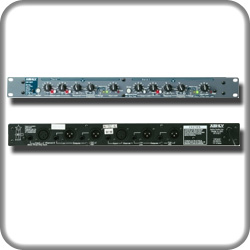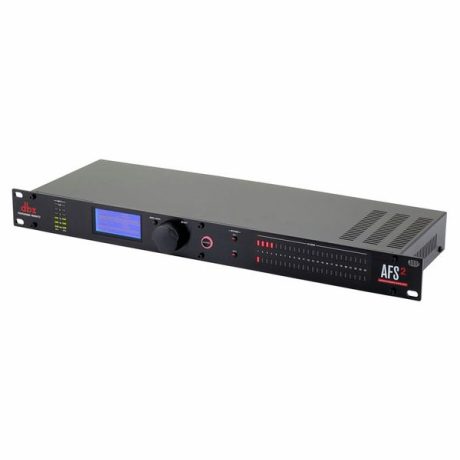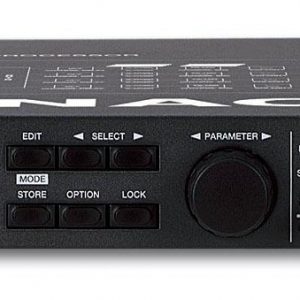| Content |
The XR-Series crossovers are the product of an intensive research effort started in 1972 which combined a reexamination of traditional crossover theory with practical field use. Over the years, a number of refinements and new models have been added to our crossover series, but the original design goals have remained the same: to produce a crossover which is sonically accurate, is flexible enough to suit a wide variety of systems, and affords maximum protection for speakers and drivers.
All Ashly crossovers are based upon the same powerful state-variable filter circuit, which guarantees that two adjacent frequency band outputs always remain in phase. Our crossovers offer a number of useful and unusual features, including continuous tuning, a response control, and a unique output stage which maintains low noise at any level setting. These models also include a 200:1 tuning range, output mute switches, and both TRS and XLR connectors. Like other Ashly products, your crossover features low noise and distortion, active balanced inputs, a peak level indicator, a precision regulated power supply, protection against abnormal input or output conditions, and rugged mechanical construction. Conservative design and an unusually thorough procedure for quality control have earned Ashly a reputation for dependability in the recording, sound reinforcement, and broadcast fields.
Response Control an Ashly Exclusive...
This control, found adjacent to the crossover frequency control, adjusts the damping of the filter affecting the response shape of the filters at the crossover point. The dial calibrations refer to the amount of attenuation effected by the filter at the crossover frequency, i.e., a setting of 3dB means that the filter's high-pass and low-pass outputs are each "rolled off 3dB at the crossover point“. This describes Butterworth filter response, or a gentle 3dB peak at the crossover point when the two filter output signals overlap. To obtain a flat signal, or "Linkowitz-Riley" response through the crossover region, set the Response control to "6“. This attenuates each output of the filter by 6dB at the crossover point (two identical signals added together yield a +6dB increase). To obtain a notch at the crossover point, turn down the response control past "6" to best suit your needs.
The purpose of this control is to help offset the inaccuracies inherent in typical loudspeakers, thereby helping you to achieve a flat system response. NOTE: The Response control is not a "slope" control. A 24dB/octave crossover will always have a slope of 24dB/octave. The Response control only affects filter response shape in the immediate vicinity of the crossover frequency; the ultimate crossover slope is a fixed parameter.
|
24dB/Octave Slopes |
|
Variable Filter Response Allows Tuning-In Linkwitz-Riley or Other Filters |
|
Output Mute Switches |
|
Balanced Inputs and Outputs |
|
20Hz Third Order High Pass Filter |
|
XLR and 1/4" TRS Audio Connections |
|
Peak Overload Warning LEDs |
|
Five Year Warranty | |
The Soundweb London BLU-160 offers configurable I/O, configurable signal processing and a high bandwidth, fault tolerant digital audio bus.
The BLU-160 has open architecture which is fully configurable through HiQnet™ London Architect. A rich palette of processing and logic objects and a "drag and drop” method of configuration provide a simple and familiar design environment.
This processor features a low latency, fault tolerant digital audio bus of 256 channels which uses standard Category 5e cabling giving a distance of 100m between compatible devices. Fiber media converters can be used to increase the distance between devices to over 40km.
Four card slots which accommodate analog inputs, analog outputs, digital inputs and digital outputs in banks of four facilitate many different device I/O configurations.
Analog Input Cards provide software configurable gain in 6dB steps up to +48dB per channel and software selectable Phantom Power per channel. Digital Input Cards and Digital Output Cards process AES/EBU and/or S/PDIF audio and offer a variety of clocking and syncing options. (Further information about the I/O cards can be found on dedicated datasheets)
Phantom Power, Sync, Signal Present and Clip information per channel is easily accessible, without the requirement for a PC, from clear front panel LED indication. Device-specific information such as Device Name, Device Type, Firmware Version Number, Time, IP Address and Subnet Mask is available from the front panel display. A bi-directional locate function allows devices to be identified both from and within HiQnet London Architect.
12 Control Inputs and 6 Logic Outputs allow the BLU-160 to be integrated with GPIO compatible devices. The Soundweb London Interface Kit, comprehensive documentation which details how Soundweb London systems can be integrated with third party control systems, is included within the installation of HiQnet London Architect.
The BLU-160 and the other members of the Soundweb London family provide the building blocks of the perfectly tailored system solution.
Features - Four Input / Output Card Slots
- Configurable Inputs / Outputs
- Analog Inputs (with Phantom Power per Channel)
- Analog Outputs
- Digital Inputs (AES/EBU and S/PDIF)
- Digital Outputs (AES/EBU and S/PDIF)
- Configurable Signal Processing
- Rich Palette of Processing and Logic Objects
- 256 Channel, Low Latency, Fault Tolerant Digital Audio Bus
- Clear Front Panel LED Indication
- Informative Front Panel Display
- Bi-Directional Locate Functionality
- 12 Control Inputs and 6 Logic Outputs for GPIO Integration
- Soundweb London Interface Kit for Third Party Control System Integration (Documentation)
- HiQnet Device
- Configuration, Control and Monitoring from HiQnet London Architect
| Overview
More sound to your amps and speakers
The secret to making speakers sound great lies with the crossover you use. With the dbx® 223xs Crossover you\'ll get great performance, ultra low-noise, rugged reliability and four decades of dbx knowledge and expertise in building the world\'s finest processors. The 223xs uses precision filters to separate the audio signal and direct the correct frequencies to your loudspeaker drivers. By directing only the specific frequency bands to each speaker driver the 223xs leaves your amplifiers free to use their full power on the usable signal eliminating distortion and giving your PA system a cleaner and better sound.
The dbx 223xs is a dual channel crossover with all the features you would expect from a professional product. It features Linkwitz-Riley 24dB per octave filters, independent output gain controls for level matching, output phase inversion, 40 Hz low cut filter, and optional mono summing of the low frequency (subwoofer) output. Everything in the design exudes great precision from the solid "click" controls to the high quality XLR inputs and outputs
Features
- XLR balanced ins and outs
- Mode switch for stereo 2-way or mono 3-way operation
- Low frequency summed (subwoofer) output
- x10 range switch on both channels
- 40Hz high pass (low cut) filter both channels
- Phase reverse switch on all outputs
- Individual level controls on all outputs
- 24dB per octave Linkwitz-Riley filters (the professional standard)
- Stereo/Mono status LEDs indicate the selected mode
- dbx® 2 year parts and labor as standard
- CSA NRTL/C approved
- CE compliant
Specifications
| Input Connectors |
XLR (pin 2 hot) |
| Input Type |
Electronically balanced/unbalanced, RF filtered |
| Input Impedance |
Balanced >50k ohm, unbalanced >25k ohm |
| Max Input |
>+22dBu balanced or unbalanced |
| CMRR |
>40dB, typically >55dB at 1kHz |
| Output Connectors |
XLR |
| Output Type |
Impedance-balanaced/unbalanced, RF filtered |
| Output Impedance |
Balanced 200 ohm, unbalanced 100 ohm |
| Max Output |
>+21dBu balanced/unbalanced into 2k ohms or greater |
| Bandwidth |
20Hz to 20kHz, +/-0.5dB |
| Frequency Response |
90 kHz, +0/-3 dB |
| Signal to Noise Ratio |
Ref: +4 dBu, 22 kHz measurement bandwidth |
| Signal-to-Noise (Stereo Mode) |
>94dB (Low Output), >91dB (High Output) |
| Signal-to-Noise (Mono Mode) |
>94dB (Low Output), >93dB (Mid Output), >91dB (High Output) |
| Dynamic Range |
> 106 dB, unweighted, any output |
| THD+Noise |
< 0.004% at +4 dBu, 1 kHz; < 0.04% at +20 dBu, 1 kHz |
| Interchannel Crosstalk |
< -80 dB, 20 Hz to 20 kHz |
| Crossover Frequencies (Stereo Mode) |
Low/High: 45 to 960 Hz or 450 Hz to 9.6 kHz (x10 setting) |
| Crossover Frequencies (Mono Mode) |
Low/Mid: 45 to 960 Hz or 450 Hz to 9.6 kHz (x10 setting); Mid/High: 45 to 960 Hz or 450 Hz to 9.6 kHz (x10 setting) |
| Crossover Filter Type |
Linkwitz-Riley, 24 dB/octave, state-variable |
| Low cut Switch |
Activates 40 Hz Butterworth, 12 dB/octave high-pass filter, one switch per channel. |
| Phase Invert Switch |
Inverts the phase at the output, one switch per output. |
| x1 / x10 Switch |
Multiplies the low-high(mono: low/mid and high/mid) crossover frequency range of the front-panel markings by a factor of 1 or 10, one switch per channel. |
| Mode Switch |
Selects stereo/mono and 2/3-way operation |
| LF Sum Switch |
Selects normal (stereo) or mono-summed low frequency operation and disables Ch 2ʼs low output phase invert LED to indicate that this output is not operational in the LF sum mode. |
| Indicators |
Stereo Operation (Green); Mono Operation (Yellow); Low Cut (Red-per channel); x10 (Green-per channel); Phase Invert (Red-per output) |
| Operating Voltage |
100 VAC 50/60 Hz; 120 VAC 60 Hz 230 VAC50 HZ |
| Operating Temperature |
32°F to 113°F (0°C to 45°C) |
| Power Consumption |
15W |
| Power Connector |
IEC receptacle |
| Dimensions |
1.75" H X 19" W X 6.9" D (4.4cm x 48.3cm x 17.5cm) |
| Unit Weight |
3.7 lbs. (1.7 kg) |
| Shipping Weight |
5.4 lbs. (2.5 kg) |
|
Providing 48-bit filter algorithms, 24-bit AD/DA conversion and a dynamic range of 115 dB, the DSP 244 sets new standards for digital loudspeaker controllers and processors. The DSP 244 is an universal Digital Sound System Processor that provides 2 inputs and 4 outputs; plus internal summing of the inputs 1 and 2. Via matrix it is possible to assign the outputs to any input or to the sum of the inputs. It is further possible to establish the following configurations: Stereo or Dual 2-Way systems, 3-Way + Direct and 4-Way systems, each with Mono Subchannel, but also full range systems. High and low-pass filters are provided for the frequency crossover functions in all operation modes. The selection includes Linkwitz-Riley, Butterworth and Bessel type filters with switchable slopes between 6, 12, 18 and 24 dB/oct. A huge number of additional filters offers extremely flexible correction of the frequency response. Each input incorporates a 5-band equalizer, allowing to assign high and low-pass, high and low-shelving or parametric peak-dip filters to its individual filter sections. Next to the frequency crossover filters, four additional filters are employed in each output channel, which also can be set to work as high or low-pass, high or low-shelving filters, parametric peak-dip filters, or all-pass filters. Additional filtering is provided through 2. order high-passes for the realization of B-6 alignment, or special LPN-filters (Low-Pass Notch filters) for correcting the frequency and phase responses of optimally vented woofer cabinets. Each channel additionally provides a delay, a polarity switch, a programmable level control and a digital compressor / limiter while the master delays are located in the input channels. Datasheets / ManualsBrochure (309KB)
Mains voltage 90 - 250 V AC / 50 - 60 Hz Power consumption 20 watts Safety class I Inputs 2 x XLR IN, electronically balanced, transformer optional available 2 x XLR OUT (Direct Out) Input voltage (nominal) 1.55 V / + 6 dBu Max. input voltage 24.5 V / + 30 dBu Input impedance 20 kohms Common mode rejection > 40 dB AD-conversion 24-bit, Sigma-Delta, 128 times oversampling, linear phase Outputs 4 x XLR OUT, electronically balanced Output voltage (nominal) 1.55 V / + 6 dBu Max. output voltage 8.7 V / + 21 dBu Output impedance |
With the DSP 260 digital 2-in-6 sound system manager, DYNACORD is continuing its proud tradition in the fi eld of innovative digital signal processors.
Based on the most modern hardware, this system manager offers tried-and-tested as well as new algorithms for the simple and swift construction of active multi-way systems. As much importance has been attached here by the developers to high user-friendliness as to the realization of an extremely favorable price.
24-bit sigma-delta AD/DA converters and a 32-bit floating-point signal processor make possible a dynamic range of 111 dB. In addition to the two analog inputs, a digital stereo input in AES/EBU format is available. A -6 dB pad switch in front of the AD converters offers additional security against overload when the device is connected to mixing desks with very high output levels. The 6 individually mutable outputs are electronically balanced and available on XLR sockets. For all inputs and outputs, easily read LED level meters are provided on the front panel.
Users can choose whether to configure their own systems at the device itself using the controls and display provided or else by means of the intuitive editing software.
3-way stereo, 2-way stereo + FR, 4-way mono + FR etc. Furthermore, factory presets compatible with those of the tried-and-tested DSP-244 are available for Dynacord loudspeaker systems.
In terms of DSP, the device offers parametric and graphic EQs as well as a delay function in the input and crossover, channel EQ, channel delay and a level control with limiter in each output channel.
An RS-232 interface allows Master/Slave operation of multiple devices as well as GPI switching of settings. A PC (the editing software runs under Windows) can be connected via the USB interface on the front panel.
A variable parameter lockout function allows you to determine which settings and parameters can be accessed directly at the device. This is just one of many features that make the DSP 260 an ideal choice also for the rental business.
The wealth of features combined with its outstanding audio performance and favorable price commend this audio system manager for a multitude of professional applications.
General Mains Voltage 100-240 VAC 50-60 Hz Power Consumption 25W Audio Analog Inputs 2x XLR IN, electronically balanced, 2x XLR THRU OUT, electronically balanced Digital Inputs 1x XLR AES/EBU IN Nominal Input Voltage 1.23 V / +4 dBu Maximum Input Voltage (Without -6dB Analog Pad Engaged) 8.7 V / +21 dBu Input Impedance 10k ohm Common Mode Rejection -80 dB @ 1 kHz (typical) A/D Conversion 24-Bit Sigma-Delta Outputs 6x XLR OUT, electronically balanced Nominal Output Voltage 1.23 V / +4 dBu Maximum Output Voltage 8.7 V / +21 dBu Output Impedance 50 ohm D/A Conversion 24-Bit Sigma-Delta Frequency Response 10 Hz-22 kHz (+/- 0.5 dB) THD+N < 0.01% (band limited 22Hz-22kHz) Dynamic Range 111 dB unweighted, band limited 22 Hz - 22 kHz Interfaces USB USB Type B on front panel (PC Interface) 9-pin DSUB Software Confi gurable for GPI Preset Recall or Master/Slave Connection to second DSP 260 unit Signal Processing Sample Rate 48 kHz Data Format 24-Bit Internal Processing 32-Bit Floating Point Physical Dimensions (WxHx) 19 x 14 x 1.75 inches (482.6 x 355.6 x 44.45 mm) Weight (Net) 10.1 lb (4.6 kg) Weight (Gross) 13.0 lb (5.9 kg)
| Advanced Feedback Suppression Processor with Full LCD Display
The AFS2 Dual-Channel Advanced Feedback Suppression Processor from DBX protects your ears and audio equipment from annoying and potentially damaging audio feedback without altering your sound. The AFS2 features application-specific filter types for speech, music low, music medium, and music high. The 24 fixed or live narrow-band notch filters are capable of removing frequencies at 1/80 of an octave, ensuring an optimal frequency response without the possibility of feedback.
The front panel features the wizard function to take the guesswork out of setting up any room by incorporating an advanced feedback suppression module and providing a full LCD display for system settings and menus. Additionally, the AFS2 offers a five-segment LED for accurately monitoring input levels for each channel, while the notch filter indicator allows you to monitor the number of filters applied. Dedicated bypass buttons are included to help isolate problem channels. The rear panel offers XLR and 1/4" inputs and outputs, both switchable between +4 and -10 dB operations. A USB port has been provided for firmware updates. The AFS2 ships with a standard IEC power cable.
| Number of Channels |
2 |
| Inputs |
Connectors: Female XLR and 1/4" TRS
Type: Electronically balanced and unbalanced, RF filtered
Impedance: Balanced 50 kohm, unbalanced 25 kohm
Max Line Level: +20 dBu |
| Input CMRR |
>40 dB, typically >55dB @ 1 kHz |
| Outputs |
Connectors: Male XLR and 1/4" TRS
Type: Electronically balanced and unbalanced, RF filtered
Impedance: Balanced >120 ohms, unbalanced >60 ohms
Max Level: +20 dBu |
| A/D/A Converter |
A/D Converter: DBX type IV conversion system
A/D Dynamic Range: >113 dB A-weighted, >110 dB, unweighted, 22 kHz BW
Type IV Dynamic Range: >119 dB, A-weighted, 22 kHz BW; >117 dB, unweighted, 22 kHz BW
A/D Conversion: 24-bit
Sample Rate: 48 kHz
D/A Dynamic Range: 112 dB A-weighted, 109 dB unweighted
D/A Conversion: 24-bit |
| Dynamic Range |
109 dB A-weighted, 106 dB unweighted, 22 kHz BW |
| THD + Noise |
0.003% typical at +4 dBu, 1 kHz |
| Frequency Response |
20 Hz to 20 kHz, ±0.5dB |
| Crosstalk |
Interchannel Crosstalk: >80 dB typical
Crosstalk Input to Output: >80 dB |
| Power |
US: 100 to 120 VAC 60 Hz
EU: 220 to 240 VAC 50 Hz
9 W |
| Dimensions (HxDxW) |
1.8 x 5.8 x 19.0" / 4.4 x 14.6 x 48.3 cm |
| Weight |
4.5 lb / 2.0 kg |
|

















Reviews
There are no reviews yet.